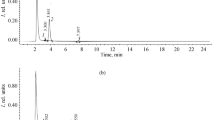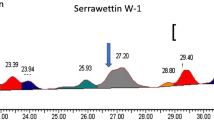Abstract
The levels penitrem A, B, C, D, E, F, roquefortine C and thomitrem A and Erecovered from extracts of 36 Norwegian, 2 American and one each of Japanese,German, South African, Danish and Fijian isolates of Penicillum crustosumThom were quantitatively determined using high performance liquid chromatography-mass spectrometry (HPLC-MS). Forty-two of the 44 isolates of penitrem-producing isolates grown on rice, afforded levels of thomitrem A and E comparable to that of penitrem A. Thomitrems A and E were also found, but at lower levels, when cultures were grown onbarley. No thomitrems were found when the isolates were grown on liquid media. Theeffects of time and temperature on mycotoxin formation were studied on rice over a 4week period at 10, 15 and 25 °C, respectively. No mycotoxins could be detectedafter 1 week at 10 °C, but after 2 weeks at 10 °C levels were similar tothose produced at 15 and 25 °C. Higher levels of thomitrems A and E weredetected when media were maintained at lower pH. The possibility that thomitremsA and E might be derived by acid promoted conversion of penitrems A and E wasexplored in stability trials performed at pH 2, 3, 4, 5 and 7 in the presence and absenceof media. Thomitrems were formed at pH 2, 3 and 4 but not at pH 5 and 7.
Similar content being viewed by others
References
Rundberget T, Wilkins A. Thomitrems A and E, two indole-alkaloid isoprenoids from Penicillium crustosum Thom. Phytochemistry 2002; 61: 979–985.
De Jesus AE, Steyn PS, Van Heerden FR, Vleggaar R, Wessels PL. Tremorgenic mycotoxins from Penicillium crustosum: Isolation of penitrems A–F and the structure elucidation and absolute configuration of penitrem A. J Chem Soc Perkin Trans 1983; 1: 1847–1856.
De Jesus AE, Steyn PS, Van Heerden FR, Vleggaar R, Wessels PL. Tremorgenic mycotoxins from Penicillium crustosum: Structure elucidation and absolute configuration of penitrems B–F. J Chem Soc Perkin Trans 1983; 1: 1857–1861.
Naik JT, Mantle PG, Sheppard RN, Waight ES. Penitremones A–C, Penicillium metabolites containing an oxidised penitrem carbon skeleton giving insight into structure-tremorgenic relationships. J Chem Soc Perkin Trans 1995; 1: 1121–1125.
Hosoe T, Nozawa K, Udagawa S, Nakajima S, Kawai K. Structures of new indoloditerpenes, possible biosynthetic precursors of the tremorgenic mycotoxins, penitrems, from Penicillium crustosum. Chem Pharm Bull 1990; 38: 3473–3475.
Yamaguchi T, Nozawa K, Hosoe T, Nakajima S, Kawai K. Indoloditerpenes related to tremorgenic mycotoxins, penitrems, from Penicillium crustosum. Phytochemistry 1993; 32: 1177–1181.
Arp LH, Richard JL. Intoxication of dogs with the mycotoxin penitrem A. J Am Vet Med Assoc 1979; 175: 565–566.
Hocking AD, Holds K, Torbin NF. Intoxication by tremorgenic mycotoxin (penitrem A) in a dog. Aust Vet J 1988; 65: 82–85.
Naudé TW, O'Brien OM, Rundberget T, McGregor ADG, Roux C, Flåøyen A. Tremorgenic neuromycotoxicosis in two dogs ascribed to the ingestion of penitrem A and possibly roquefortine in rice contaminated with Penicillium crustosum Thom. J South African Vet Assoc 2002; 73: 211–215.
Filtenborg O, Frisvad JC, Samson RA. In: Samson RA, Hoekstra ES, Frisvad JC, Filtenborg O, eds. Introduction to food-and airborne fungi. 6th ed. Centraalbureau voor Schimmelcultures, Utrecht, 2000; 306–320.
Ciegler A, Pitt JI. A survey of the genus Penicillium for tremorgenic toxin production. Mycopathol Mycol Appl 1970; 42: 119–124.
Samson RA, van Reenen-Hoekstra ES. Introduction to food-borne Fungi. 3th ed. Centraalbureau voor Schimmelcultures, Baarn, 1988.
Rundberget T, Wilkins A. Determination of Penicillium mycotoxins in foods and feeds using liquid chromatography-mass spectrometry. J Chrom 2002; 964: 189–197.
Nielsen PV, de Boer E. In: Samson RA, Hoekstra ES, Frisvad JC, Filtenborg O, eds. Introduction to food-and airborne fungi. 6th ed. Centraalbureau voor Schimmelcultures, Utrecht, 2000; 357–363.
Frisvad JC, Samson RA. Mycotoxins produced by species of Penicillium and Aspergillus occurring in cereals. In: Chelcowski J, ed. Cereal grain, mycotoxins, fungi and quality in drying and storage. Elsevier, Amsterdam, 1991; 441–476.
Torp M, Skaar I. Fungi in waste food for feed-occurrence and potential mycotoxin production. Preliminary results. In: Husdyrsforsoksmotet (in Norwegian). 1998; 272–275.
Kawai K, Nozawa K, Yamaguchi T, Nakajima S, Udagawa S. Two chemotypes of Penicillium crustosum based on the analysis of indolic components. Proc Jpn Assoc Mycotoxicol 1992; 26: 19–24.
Frisvad JT, Filtenborg O. Terverticillate penicillia: Chemotaxonomy and mycotoxin production. Mycologia 1989; 81: 837–861.
Frisvad JT, Samson RA, In: Arora DK, Mukerji KG, Marth EH, eds. Handbook of Applied mycology. Volume 3, Foods and feeds, Marcel Dekker, New York, 1991; 31–68.
El-Banna AA, Leistner L. Production of penitrems A by Penicillium crustosum isolated from foodstuffs. Int J Food Microbiol 1988; 7: 9–17.
Hou CT, Ciegler A, Hesseltine CW. Tremorgenic toxins from penicillia. III. Tremortin production by Penicillium species on various agricultural commodities. Appl Microbiol 1971; 21: 1101–1103.
Di Menna M, Lauren DR, Wyatt PA. Effect of culture conditions on tremorgen production by some Penicillium species. Appl Environ Microbiol 1986; 51: 821–824.
Surekha M, Reddy SM. Effect of carbon and nitrogen sources on the production of penitrem B by Penicillium aurantiogriseum. Folia Microbiol 1992; 37: 47–49.
Microorganisms in foods 5, Toxigenic fungi: Penicillium, Blackie Academic & Professional, London, pp. 397–413
Miller JD, Greenhalgh R, Wang Y, Lu M. Trichothecene chemotypes of three Fusarium species. Mycologia 1991; 83: 121–130.
Hou CT, Ciegler A, Hasseltine CW. Tremorgenic toxins from penicillia II. A new tremorgenic toxin, tremortin B, from Penicillium palitans. Can. J. Microbiol 1971; 17: 599–603.
Author information
Authors and Affiliations
Rights and permissions
About this article
Cite this article
Rundberget, T., Skaar, I., O'Brien, O. et al. Penitrem and Thomitrem Formation by Penicillium crustosum . Mycopathologia 157, 349–357 (2004). https://doi.org/10.1023/B:MYCO.0000024180.99262.b1
Issue Date:
DOI: https://doi.org/10.1023/B:MYCO.0000024180.99262.b1




